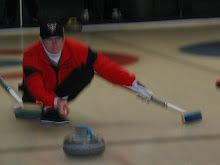 is for, well, Curling. It's what the rock does as it travels the length of the ice when you impart a spin, or turn to it upon release. The curl allows running stones to "bend" around stationary stones in order to hide behind them. Curlers use their brooms to sweep the running path of a stone in order to control how far it travels, and how much it curls. It also seems obvious that the curling motion of the rocks gives the sport its name, but that may not necessarily be the case.
is for, well, Curling. It's what the rock does as it travels the length of the ice when you impart a spin, or turn to it upon release. The curl allows running stones to "bend" around stationary stones in order to hide behind them. Curlers use their brooms to sweep the running path of a stone in order to control how far it travels, and how much it curls. It also seems obvious that the curling motion of the rocks gives the sport its name, but that may not necessarily be the case.
The origins of curling are unclear, with both Scotland, and the Low Countries claiming genesis. References to a game played by sliding heavy objects on ice are found in both Scots and Dutch arts and literature during the fifteen hundreds. As there was much trade and cultural relations between the two areas during the late fifteenth and early sixteenth centuries, the game may have originated in either locale and been transplanted to the other. The Dutch played a game on ice involving pushing large blocks of wood or clumps of frozen earth with a stick, called "kuting." In fact, many early Scottish curling stones were called "kuting" stones, and that word may have eventually evolved into the common name used today.
There is no question that it was the Scots who embraced the game, brought it to the rest of the world, and made it what it is today.
<- Start at the beginning.
February 02, 2009
The ABCs of Curling - C
Labels:
ABCs of curling
Subscribe to:
Post Comments (Atom)







6 comments:
Go, go, go, Mr. Wizard!
I is enthralled!!
Brent
dear Paul, ah!:)Curling:)
I have to ask people to come over and read this!
hugs,natalie
Dear Paul,
Please come over to my blog at Lurkynat with some Canadians. I need to hear your point of view on the rights that you hold sacred as a Canadian!Thanks in advance I(I hope)
natalie
Drooping by to wish a Happy Birthday Paul :) Hope it was a good one :)
I little Wisconsin birdie tells me it's your birthday. Have a great one!
Beth
Thankk you for this
Post a Comment